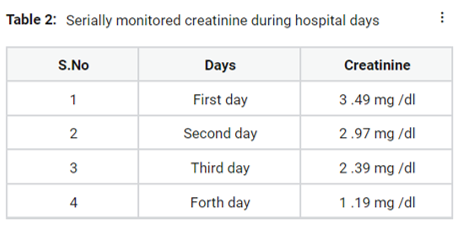Abstract
Averrhoa bilimbi is a fruit have high oxalic acid content. Excess intake of this fruit will cause acute kidney injury due to high oxalate concentration, and also increase creatinine. In case of high consumption, the only remedy is hemodialysis, but in lower consumption, the renal function will recover without specific treatment. Bilimbi contains 25.1% of oxalate, and its consumption carries a high risk of developing acute kidney injury by deposition of calcium oxalate crystals in renal tubules. The fruit plays an important role in nutrient profile like contain carbohydrates, fibers, proteins, vitamin C, vitamin B, calcium, iron, flavonoids, tannins and terpenes. It also helps to reduce the weight loss due to the high amount of dietary fiber found in bilimbi, which helps to control body weight. Here a male patient who consumed bilimbi fruit per day approximately 30 – 40 and his creatinine level become elevated to 3. 49 mg/dl. With conservative treatment, the patient creatinine becomes normal within one week without dialysis. In some cases did not show oxalate crystals because of low urine excretion, here the patient had oliguria, and because of that, no oxalate crystals were found. Here the main parameter was creatinine, and during admission, the serum creatinine was 3. 49 mg/dl on the first day then 2. 97 mg/dl on the second day, 2.39 mg/dl on the third day and 1.19 mg/dl on forth day and from the fifth day to the seventh day the patient was serially monitored the serum creatinine. It was 1. 19 mg/dl.
Full text article
References
Barman, A. K., et al. 2016. Acute kidney injury associated with ingestion of star fruit: Acute oxalate nephropathy. Indian Journal of Nephrology, 26(6):446–448.
Caetano, C. P., et al. 2017. Neurotoxicity following the Ingestion of Bilimbi Fruit (Averrhoa bilimbi) in an End-Stage Renal Disease Patient on Hemodialysis. Case Reports in Nephrology and Dialysis, 7(1):6–12.
Gupta, R. D., et al. 2016. Acute Oxalate Nephropathy Due to Bilimbi Poisoning: A Case Report. International Journal of Medical Students, 4(1):33–35.
Jha, V., Parameswaran, S. 2013. Community acquired acute kidney injury in tropical countries. Nature Reviews Nephrology, 9(5):278–290.
Konta, T., et al. 1998. Acute Renal Failure due to Oxalate Ingestion. Internal Medicine, 37(9):762– 765.
Mahamoodh, Z. S. K., et al. 2018. A case series on Averrhoa bilimbi induced acute oxalate nephropathy; an experience from a tertiary center in Kerala, India. Journal of Nephropathology, 7(4):296–300.
Nair, S., et al. 2014. Acute Oxalate Nephropathy following Ingestion of Averrhoa bilimbi Juice. Case Reports in Nephrology, pages 1-5.
Neto, M. 2014. Star fruit as a cause of acute kidney injury: a case report. Brazilian Journal of Nephrology, 36(2):118–120.
Neto, M., et al. 1998. Intoxication by star fruit (Averrhoa carambola) in six dialysis patients? (Preliminary report). Nephrology Dialysis Transplantation, 13(3):570–572.
Sá, R. D., Vasconcelos, A. L., et al. 2019. Anatomy, histochemistry and oxalic acid content of the leaflets of Averrhoa bilimbi and Averrhoa carambola. Revista Brasileira de Farmacognosia, 29(1):11–16.
Samad, T., et al. 2017. Community-Acquired Acute Kidney Injury from Edible Agents: Report from a Developing Country. Bangladesh. The Open Urology & Nephrology Journal, 10(1):20–28.
Unni, V. N., et al. 2013. Acute oxalate nephropathy due to ′Averrhoa bilimbi′ fruit juice ingestion. Indian Journal of Nephrology, 23(4):297–300.
Authors

This work is licensed under a Creative Commons Attribution-NonCommercial-NoDerivatives 4.0 International License.

